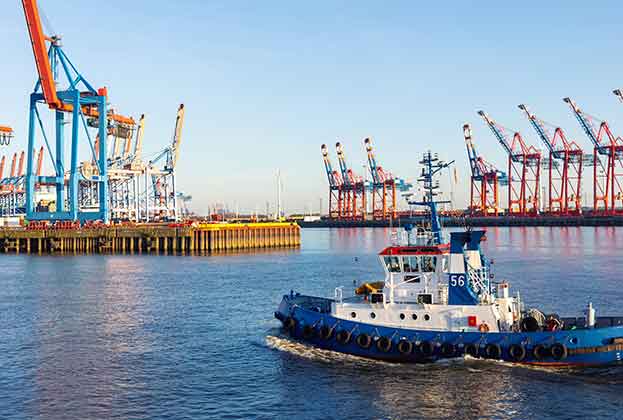Investors are increasingly cautious when deploying capital into logistics, despite the fact that many institutions continue to openly back the sector
Europe, Middle East, and Africa (EMEA)
Investment volumes declined by 50% YoY across Europe in the second quarter. Investors are increasingly cautious when deploying capital into logistics, despite the fact that many institutions continue to openly back the sector (one could argue that this is more reflective of a hesitation to invest in real estate full stop, as opposed to being specifically focused on logistics). Risk aversion is pervasive. Investors are increasingly demanding properties that meet very specific criteria, including super prime locations, long leases, strong covenants, and robust ESG credentials. Any shortfall across these criteria provides an excuse not to transact, which represents a major about-turn in attitude from the feeding frenzy of the last few years.
When investors do commit, there is a bias towards transacting on smaller, more liquid lot sizes, particularly given debt financing is proving difficult to secure on larger assets. In Germany, for example, very few transactions in excess of €50 million have exchanged so far this year. Transactions are also taking much longer to complete as risk aversion elongates the due diligence process.
Occupational demand in Europe is also experiencing a cyclical slowdown in line with the deteriorating economic environment, with the euro area slipping into recession. In general, the larger, more mature markets are bearing the brunt of the downturn. Across Spain, France, and the Netherlands, for example, take-up in Q2 was down by around one-third in comparison with last year. Secondary markets, including Eastern Europe, Ireland, Italy, and Portugal, are showing more resilience and performing better than their core peers.
Some markets are also seeing an influx of new supply, exacerbating the decline in demand in the occupational market. Madrid is expected to onboard around 11.8 million sq ft of space in 2023, equivalent to around 9% of existing stock. This will push the vacancy rate higher, which has already risen by nearly one percentage point in the first half of this year.
Even in the UK, where take-up experienced a much more pronounced 70% decline YoY in the second quarter, a vacancy rate of 6.3% remains well below historical thresholds
Eri Mitsostergiou, Director, World Research
However, it is important to consider the context behind all these figures: vacancy rates are a long way from critical levels. Returning to Madrid, for example, the current vacancy rate of 7.2% remains below the pre-Covid record low of 7.8%. Similar trends are playing out across other European markets.
Even in the UK, where take-up experienced a much more pronounced 70% decline YoY in the second quarter, a vacancy rate of 6.3% remains well below historical thresholds that would imply a turning point in rental growth. Furthermore, active requirements in the market, which typically lead take-up by nine months, are around 64% up on the year, suggesting the slowdown will be short-lived. Leasing deals, much like transactions, are just taking longer to finalise.
North America
Investment in the US logistics sector fell by nearly 46% YoY in Q2 to US$21.9 billion. However, base effects are also important in contextualising this decline. Investment volumes are still above the pre-Covid five-year average following several years of extraordinary market activity. Well-located assets, in close proximity to major transportation hubs and with access to densely populated areas, continue to attract buyers at very competitive prices.
Nevertheless, this return to ‘normal’ is presenting some challenges for investors. The primary issue is – as ever – with rising interest rates, which has underpinned an outward movement in yields and compressed risk premiums. In the second quarter, prime benchmark yields rose by a further 50 bps in Chicago and Houston, and 25 bps in Los Angeles. This implies that those investors who bought at the peak of the market are now sitting on unrealised capital value losses of up to 25% based on the shift in yields.
The second issue is with a slowdown in occupational demand. The Los Angeles market, for example, has now experienced three consecutive quarters of negative net absorption, in line with a slowdown in container throughput at the nearby ports of Los Angeles and Long Beach. This has underpinned a rise in the vacancy rate of more than 200 bps over the last 12 months. Northern New Jersey is also experiencing a slowdown in demand, which is prompting many occupiers to return sublease space to the market. In Houston, meanwhile, the problem is that a record amount of new supply is hitting the market this year, which is outrunning still healthy demand, pushing the vacancy rate up by 70 bps in Q2 alone.
While economic uncertainty continues to weigh on market sentiment in the short-term, institutional investors still hold a bullish long-term outlook, and the outward shift in yields is attracting more interest in the sector again
Eri Mitsostergiou, Director, World Research
Nevertheless, vacancy rates remain below pre-Covid levels in most markets, and the sector is considered healthy enough to absorb new stock without materially changing the outlook. High supply markets are generally well-matched with the high growth markets. And once we are through the wave of completions, new starts are falling off a cliff as developers react to the evolving economic landscape, which will put a cap on any future rise in vacancy.
Landlords retain pricing power as a consequence, and strong rental growth over the last 12 months is more than enough to cushion the impact of higher yields. Average asking rents across the four markets covered here are up by more than 9% over the last 12 months, outstripping the headline 3% inflation rate over the same period. The Los Angeles market is still one of the healthiest given the persistent tight market conditions, with a vacancy rate of 3.7%, below the nationwide average of 4.8%. Recent rental growth is clearly unsustainable, but landlords remain confident of solid gains in the future.
While economic uncertainty continues to weigh on market sentiment in the short-term, institutional investors still hold a bullish long-term outlook, and the outward shift in yields is attracting more interest in the sector again. New investors continue to enter the market with a view to building exposure to the logistics sector. Increasing clarity on both market conditions and the eventual resolution of inflation and interest rate hikes will further support investor confidence and lead to stable pricing and higher transaction volumes. This is underpinned by the sector’s strong mid to long-term growth potential, driven by the continuous growth of e-commerce and a policy-induced resurgence in domestic manufacturing, which is supporting a boom in the construction of production facilities in the US.
Asia Pacific
Asia Pacific experienced a relatively modest 14% YoY decline in investment volumes in the second quarter of 2023. While the region adapts to a rapidly evolving economic environment, investors, on the whole, retain strong interest in the sector, and the fundamentals support long-term growth, seeking opportunities in various markets and capitalising on the growing demand for logistics and warehousing facilities.
This optimism is tempered in some markets, where a combination of new supply onboarding and weaker demand is weighing on the outlook for vacancy and rent. This is true in Shanghai, for example, where the recent stability in rents will be challenged by a vacancy rate that rose to 14.8% in Q2.
Oversupply is also a concern in South Korea, where the vacancy rate rose by 70 bps to 7.0% in the second quarter. Investors are increasingly cautious as a result; transactions which were closed or under discussion during the quarter mostly involved well-located, high-quality, or fully-occupied assets at market rental levels, with few investors willing to accept any leasing risk. The benchmark yield remained steady at 5.3% in Q2 as the Bank of Korea paused the policy rate tightening cycle, but a deteriorating occupier outlook will put upward pressure on yields in the next 12 months.
In Japan, the logistics sector retains its allure amongst investors, particularly those cross border investors looking to gain exposure to the Japanese market, but unwilling to look at offices. However, again, a large supply overhang, particularly in the Greater Tokyo and Greater Osaka markets, is leading to a noticeable rise in vacancy, which is weighing on the pricing power of landlords. Poorly located and older facilities will struggle as a consequence, and prospects for rental growth is limited at a time when the Japanese economy is finally experiencing sustained inflation.

In Australia, deal activity remains limited, although there are a number of transactions that are in the pipeline, which should help to support investment volumes and advance price discovery, which is relying more on evidence than sentiment (and is therefore slow to adjust). Supply is not an issue in Australia, and investors remain largely positive on the sector, underpinned by the very low vacancy rate, which in Sydney is below 1%. This should continue to support positive rental growth, which favours short-lease assets with reversionary upside potential. The benchmark yield for Sydney rose by 25 bps to 5.0% in Q2, but this should be sufficient to unlock more transactional activity, with the RBA nearing the end of its tightening cycle.
In India, the first half of 2023 saw a substantial absorption of around 11.2 million sq ft in tier 1 cities, with the 3PL sector playing a pivotal role in driving demand, accounting for 40% to 50% of the total absorption. Additionally, the manufacturing sector witnessed a significant surge in activity, fuelled by various incentive schemes such as the Production Linked Incentive Scheme (PLI). We anticipate increased interest from investors in 2023, underpinned by inherent domestic demand and the expansion of distribution networks in tier 2 and tier 3 cities, indicating a broader interest in regional growth opportunities.
Read the articles within Taking Stock: Capital Markets Quarterly – Q2 2023 below.
.jpg)




